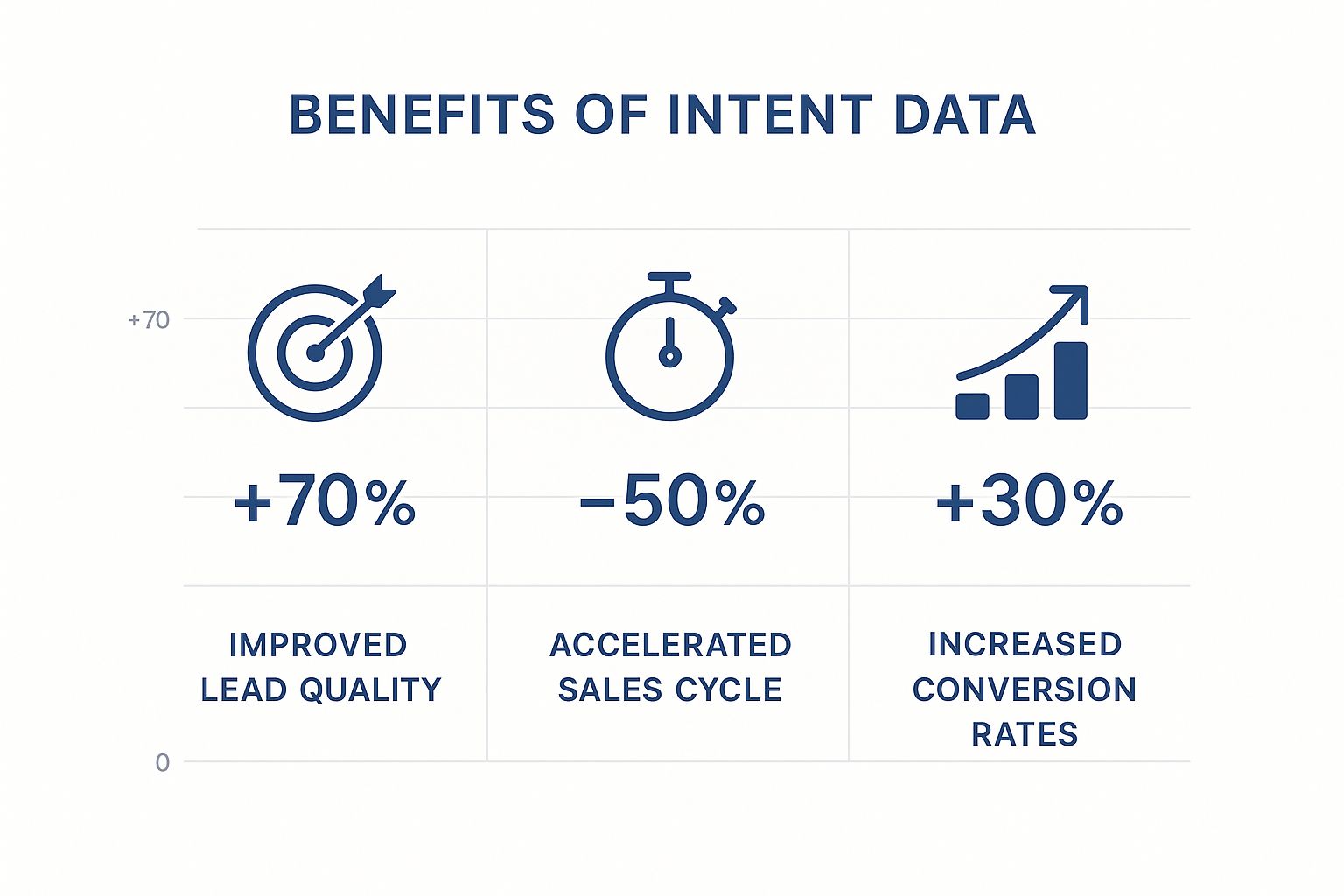B2B Data Enrichment: Boost Sales & Marketing Insights
Learn how B2B data enrichment transforms raw contacts into valuable insights. Discover strategies and tools to enhance your sales and marketing...
Learn what is intent data and how it helps you find B2B buyers who are ready to purchase. Unlock powerful strategies for your sales and marketing teams.
TL;DR: Intent data is the digital breadcrumb trail that tells you which prospects are actively researching a solution like yours. It lets your team engage accounts with timely, relevant conversations instead of blasting out cold outreach and just hoping for the best.

Imagine your ideal customers are leaving clues all over the internet. They're reading articles, visiting competitor websites, and searching for specific solutions to their biggest problems. Intent data is simply the process of gathering all those clues.
For B2B teams, this is a massive advantage. It helps you see which accounts are "in-market" and actively evaluating options right now—often long before they ever visit your website or fill out a form.
This isn't just about guessing who to target; it's about focusing your precious time and resources on prospects who have already signaled they're interested. This whole approach is a cornerstone of what is data-driven marketing, where real insights guide your strategy.
Ultimately, these buying signals are the engine of modern B2B sales. They power everything from highly targeted ad campaigns to personalized outreach that actually resonates. It's also a key ingredient in any top-tier sales intelligence platform, which helps turn all that raw noise into real, actionable opportunities.
When you understand these signals, you can engage prospects at the perfect moment, dramatically increasing your odds of starting a valuable conversation and, ultimately, closing the deal.

Imagine you’re trying to find your ideal customer in a massive, packed stadium. You could stand in the middle and shout, hoping the right person hears you. Or, you could spot the small group in the stands already waving a sign with your company's name on it.
That's what intent data does. It helps you find that group, every single time.
It’s the "digital body language" that shows a prospect is interested long before they ever fill out a form or book a demo. This is especially crucial in B2B, where buyers do a huge chunk of their research on their own, completely anonymously. Your traditional outreach often falls flat because it shows up way too early or far too late.
Intent data flips that entire script. Your team stops being reactive and starts getting proactive. Instead of waiting for someone to raise their hand, you can meet buyers with the right message at the exact moment they need to hear it.
Without intent data, sales and marketing teams are stuck with static criteria—company size, industry, job titles. While these firmographics are a decent starting point for building a target list, they tell you absolutely nothing about a prospect's current needs or their timing.
You're basically working off an old, outdated map. Intent data adds that critical layer of timing, showing you which accounts are actively hunting for solutions right now.
This dynamic insight lets you:
By focusing on active buyers, teams can cut through the noise and connect with prospects who are genuinely ready to talk. This precision is what separates high-performing revenue teams from everyone else.
The benefits go way beyond just finding a few warm leads. A recent survey shows B2B marketers are seeing real results: 67% use intent data for digital advertising, 62% for market intelligence, and 57% for lead generation.
But there's a catch. Despite its power, a whopping 70% of users say data quality is still the biggest hurdle, which just goes to show how important it is to have a reliable provider. You can dig into more of these trends in data technology to see what’s happening in the space.
Ultimately, bringing intent data into your workflow means you stop interrupting prospects and start having relevant, timely conversations. This fundamental shift doesn't just speed up your sales cycle; it also builds a stronger foundation for long-term customer relationships. You’re no longer just another vendor—you're a helpful advisor who showed up at exactly the right time.
To really get a handle on intent data, you first need to understand where it comes from. Think of yourself as a detective piecing together clues. Some clues you'll find at the scene of the crime, and others you'll gather from witnesses around town.
In sales, you're working with two main categories of these clues: first-party and third-party data. Each gives you a totally different, yet equally valuable, piece of the puzzle.
Imagine all the conversations happening in your own home—that's first-party data. It’s all the information you collect directly from your digital turf: your website, your CRM, your marketing automation platform, and even your product analytics.
Because this data comes straight from your audience interacting with your stuff, it’s incredibly accurate. You know with certainty who just visited your pricing page for the third time this week, who downloaded that new whitepaper, or who keeps opening your emails.
This is the bedrock for understanding how your known prospects and current customers are engaging with your brand.
It’s your most valuable asset for nurturing the leads you already have and spotting opportunities to upsell or expand existing accounts.
Key characteristics of first-party data include:
When you get this right, the results are powerful. A well-rounded intent data strategy can drive some serious improvements across the entire sales funnel.

As you can see, we're not talking small gains. Leveraging intent data properly can lead to a +70% boost in lead quality, effectively cut sales cycles in half, and increase conversion rates by a massive +30%.
Now, what if you could listen in on relevant conversations happening all over the internet, not just on your own website? That’s third-party data.
It’s collected by external providers who aggregate signals from a massive network of B2B publisher websites, industry forums, review sites, and online publications. This gives you a much broader, market-level view of what’s happening.
This data shows you which companies are actively researching topics, solutions, and even your direct competitors—often long before they’ve ever heard of your brand.
Third-party data is your early-warning system. It flags accounts that are "in-market" but are still in the early, anonymous stages of their buying journey, giving you a priceless head start to engage them before your competition even knows they exist.
This is absolutely essential for finding net-new business and filling the top of your funnel. It helps you discover companies that fit your ideal customer profile and are showing active buying signals all across the web.
So, how do these two types of data stack up against each other? Here's a simple side-by-side comparison to help you understand their distinct roles in your sales strategy.
| Attribute | First-Party Intent Data | Third-Party Intent Data |
|---|---|---|
| Source | Your own website, CRM, product analytics, and marketing platforms. | A broad network of B2B publisher sites, forums, and review sites. |
| Accuracy | Extremely high. You control the collection and know the context. | Varies by provider. Accuracy depends on their network and methodology. |
| Scale | Limited to your existing audience and known contacts. | Massive. Provides a market-wide view of anonymous research behavior. |
| Use Case | Ideal for nurturing leads, identifying upsell/cross-sell opportunities. | Perfect for top-of-funnel prospecting and discovering new accounts. |
While each type of data is powerful on its own, the real magic happens when you combine them. The most sophisticated sales teams don't choose one over the other; they blend the precision of first-party data with the scale of third-party data. This creates a complete, 360-degree view of the buyer's journey, from their earliest anonymous research to their final clicks on your pricing page.

Knowing the theory behind intent data is one thing. Seeing it in action is where the magic really happens. For B2B companies, these digital breadcrumbs are the fuel for smarter, more efficient growth across the board, from marketing all the way to sales.
Instead of casting a wide, expensive net and hoping for the best, teams can focus their energy with surgical precision. This shift from volume to value is what separates high-performing revenue teams from the rest of the pack.
For marketers, intent data is like a cheat code for relevance. It takes the guesswork out of campaign planning and content creation, making sure your efforts land with an audience that's actually listening.
This is especially critical in account-based marketing (ABM), where focusing on the right accounts at the right time is the entire ballgame.
With these insights, marketers can:
This proactive approach is driving serious market growth. The global B2B Buyer Intent Data Tools market was valued at around $1.2 billion and is projected to hit nearly $4.8 billion, reflecting a compound annual growth rate of about 16.5%. Personalized marketing fueled by intent data is a huge driver of this expansion.
For sales teams, intent data is the ultimate conversation starter. It transforms cold, generic outreach into warm, relevant discussions that speak directly to a buyer’s immediate needs.
This insight gives sales reps a critical advantage, letting them engage prospects with confidence and, most importantly, context. The impact on the sales process is direct and measurable.
By knowing an account is already exploring a solution, a sales rep can skip the introductory fluff and get straight to the heart of the buyer's problem. This simple shift can cut the sales cycle by weeks, or even months.
Sales teams use these signals to:
Ultimately, integrating intent data creates a powerful feedback loop between sales and marketing. Marketing delivers higher-quality, in-market leads, and sales converts them more effectively because they arrive with the context needed to win. For a deeper dive into practical applications, exploring effective B2B lead generation strategies can further illustrate how this data fuels market expansion.
Getting your hands on intent data is a great start, but let's be honest—raw information doesn't close deals. The real trick is turning those thousands of digital breadcrumbs into clear, actionable sales plays your team can actually use. This is where a specialized platform like Salesmotion becomes the bridge between data and revenue.
Think of raw intent data like a list of interesting addresses. You know where the activity is happening, but you have no idea who is inside the house, what they're talking about, or why you should knock on their door right now. A powerful platform translates that raw data into a complete story.
Salesmotion is built to connect these dots for you, automatically. It doesn't just show you that a target account is active; it delivers the deep context your sales team needs to engage with confidence and relevance. This process turns a simple signal into a genuine strategic advantage.
The workflow is straightforward but incredibly powerful:
This isn't just about data enrichment; it's about making intent data operational. A signal—like a prospect researching your competitor—can automatically trigger a personalized, pre-built outreach sequence for the right contacts at that account.
Let’s make this real. Imagine one of your target accounts, a large manufacturing firm, suddenly starts digging into "supply chain optimization software."
Without a platform, this signal would likely get lost in a sea of data. With Salesmotion, a sequence of events kicks off instantly. The platform identifies the surge and flags the account as "in-market." It then surfaces the VP of Operations and the Director of Logistics as the most relevant contacts, based on their roles and recent online behavior.
At the same time, it can push an alert to the account executive in your CRM, complete with a pre-populated email template that speaks directly to the challenges of supply chain logistics. The rep doesn't have to burn hours on manual research. They can act immediately with a message that’s both timely and hyper-relevant.
Ultimately, the goal is to make intent data not just accessible but usable at scale. Platforms like Salesmotion automate the heavy lifting of interpretation, freeing up your sales team to focus on what they do best: building relationships and closing deals. It transforms the abstract concept of "buyer intent" into a repeatable process for generating pipeline. To see how this fits into a broader strategy, you can learn more about the importance of comprehensive account data in modern sales.
Looking ahead, the real magic happens when you pair intent data with Artificial Intelligence. If intent data tells you what your buyers are researching, AI is the engine that tells you what to do about it—with incredible speed and precision.
This partnership moves you from simply reacting to buyer signals to proactively anticipating their needs. It’s a huge leap forward in how we understand and act on what’s happening in the market.
Let's face it, raw intent data can be overwhelming. AI algorithms are built to analyze massive, complex datasets that no human could ever tackle. They can sift through millions of signals to spot the subtle patterns, predict which accounts are actually likely to buy, and score leads with far greater accuracy.
This synergy helps you:
The AI marketing market, valued at $47.32 billion, is set for explosive growth with a forecasted 36.6% CAGR. It's not just hype. Marketers combining AI with buyer intent are seeing real results, like 26% better ad targeting and 32% higher conversion rates. This dynamic duo is a key growth driver, and you can get more insights on how this trend will impact sales over the next 5 years.
By using AI to interpret intent data, teams can personalize outreach at a scale that was previously impossible, ensuring every interaction is both timely and relevant.
This combination is absolutely central to the future of B2B sales. It lets your team segment audiences with surgical precision and deliver personalized experiences that actually resonate with buyers.
This approach is a core principle of modern revenue strategies like signal-based selling, which is all about acting on real-time buyer behavior. By learning how to interpret and act on these AI-driven insights, your team can build a much more predictable and powerful sales pipeline.
Intent data is a collection of online behavioral signals that indicate a person or company is actively researching a product or service. This includes activities like reading articles on specific topics, visiting competitor websites, or searching for keywords related to a business challenge. It helps you identify who is "in-market" for a solution like yours.
Engagement data tracks how known contacts interact with your assets—like your website, emails, and content. It's focused on your digital property. Intent data tracks anonymous research behavior across the wider internet, showing you which accounts are exploring solutions long before they ever land on your site.
Absolutely. While enterprise-level tools offer broad third-party data, any business can start by leveraging its own first-party data. Analyzing your website traffic, CRM activity, and content downloads is a powerful and low-cost way to identify intent signals from your existing audience.
The quality varies by provider. Reputable vendors use vast data networks and sophisticated verification methods to ensure accuracy. The most effective strategy is to combine reliable third-party data (to find new opportunities) with your own first-party data (to validate interest).
Stop guessing which accounts are ready to buy. With Salesmotion, you can turn real-time signals into actionable sales plays that accelerate your pipeline. See how our AI-powered account intelligence platform can help you save time and close more deals. Learn more about Salesmotion.
Learn how B2B data enrichment transforms raw contacts into valuable insights. Discover strategies and tools to enhance your sales and marketing...
Discover what is a buying signal in sales with our guide. Learn to spot verbal and digital cues to qualify leads and close deals faster.
Discover what is a buying signal and learn how to recognize verbal and digital cues in B2B sales to close deals faster and boost your pipeline.